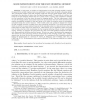Free Online Productivity Tools
i2Speak
i2Symbol
i2OCR
iTex2Img
iWeb2Print
iWeb2Shot
i2Type
iPdf2Split
iPdf2Merge
i2Bopomofo
i2Arabic
i2Style
i2Image
i2PDF
iLatex2Rtf
Sci2ools
SIAMSC
2010
2010
Some Improvements for the Fast Sweeping Method
In this paper, we outline two improvements to the fast sweeping method to improve the speed of the method in general and more specifically in cases where the speed is changing rapidly. The conventional wisdom is that fast sweeping works best when the speed changes slowly, and fast marching is the algorithm of choice when the speed changes rapidly. The goal here is to achieve run times for the fast sweeping method that are at least as fast, or faster, than competitive methods, e.g. fast marching, in the case where the speed is changing rapidly. The first improvement, which we call the locking method, dynamically keeps track of grid points that have either already had the solution successfully calculated at that grid point or for which the solution cannot be successfully calculated during the current iteration. These locked points can quickly be skipped over during the fast sweeping iterations, avoiding many time-consuming calculations. The second improvement, which we call the two queue...
| Added | 21 May 2011 |
| Updated | 21 May 2011 |
| Type | Journal |
| Year | 2010 |
| Where | SIAMSC |
| Authors | Stanley Bak, Joyce R. McLaughlin, Daniel Renzi |
Comments (0)

